Vil vi nogensinde se et sort hul?
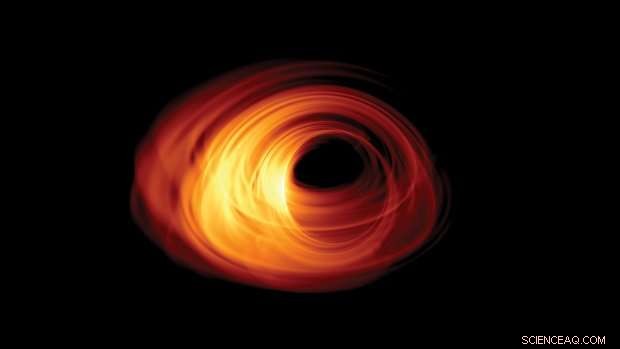
Skyggen af et sort hul omgivet af en ring af ild i en generisk simulering. Kredit:T. Bronzwaer, M. Moscibrodzka, H. Falcke Radboud Universitet
I de sorte hullers skyggeområder støder to grundlæggende teorier, der beskriver vores verden sammen. Kan disse problemer løses, og eksisterer der virkelig sorte huller? Først, vi skal måske se en, og videnskabsmænd forsøger at gøre netop dette.
Af alle fysikkens kræfter er der én, som vi stadig slet ikke forstår:Tyngdekraften.
Tyngdekraften er hvor grundlæggende fysik og astronomi mødes, og hvor de to mest fundamentale teorier, der beskriver vores verden – kvanteteori og Einsteins teori om rumtid og tyngdekraft (alias teorien om generel relativitet) – støder direkte sammen.
De to teorier er tilsyneladende uforenelige. Og for det meste er dette ikke et problem. De lever begge i forskellige verdener, hvor kvantefysikken beskriver de helt små, og generel relativitetsteori beskriver de allerstørste skalaer.
Kun når du kommer til meget små skalaer og ekstrem tyngdekraft, kolliderer de to teorier, og på en eller anden måde, en af dem tager fejl. I hvert fald i teorien.
Men der er engang et sted i universet, hvor vi faktisk kunne se dette problem opstå i det virkelige liv og måske endda løse det:kanten af et sort hul. Her, vi finder den mest ekstreme tyngdekraft. Der er kun et problem – ingen har nogensinde faktisk 'set' et sort hul.
Så, hvad er et sort hul?
Forestil dig, at hele dramaet i den fysiske verden udspiller sig i rumtidens teater, men tyngdekraften er den eneste 'kraft', der faktisk ændrer det teater, den spiller i.
Tyngdekraften styrer universet, men det er måske ikke engang en kraft i traditionel forstand. Einstein beskrev det som en konsekvens af rumtidens deformation. Og måske passer det simpelthen ikke til standardmodellen for partikelfysik.
Når en meget stor stjerne eksploderer i slutningen af sin levetid, dens inderste del vil kollapse under sin egen tyngdekraft, da der ikke længere er nok brændstof til at opretholde trykket, der virker mod tyngdekraften (ja, tyngdekraften føles trods alt som en kraft, gør det ikke!).
Sagen kollapser, og ingen kraft i naturen vides at kunne stoppe det kollaps, nogensinde.
I en uendelig tid, stjernen vil være kollapset til et uendeligt lille punkt:en singularitet – eller for at give den et andet navn, et sort hul.
Selvfølgelig, om en begrænset tid vil stjernekernen være kollapset til noget af en endelig størrelse, og dette ville stadig være en enorm mængde masse i et sindssygt lille område, og det kaldes stadig et sort hul!
Sorte huller suger ikke ind i alt omkring dem
Interessant nok, det er ikke sandt, at et sort hul uundgåeligt vil trække alt ind.
Faktisk, om du kredser om en stjerne eller et sort hul, der er dannet af en stjerne, det gør ingen forskel, så længe massen er den samme. Den gode gamle centrifugalkraft og dit vinkelmomentum vil holde dig sikker og forhindre dig i at falde i.
Kun når du affyrer dine gigantiske raketpropeller for at bremse din rotation, vil du begynde at falde indad.
Imidlertid, når du falder mod et sort hul, vil du blive accelereret til højere og højere hastigheder, indtil du til sidst når lysets hastighed.
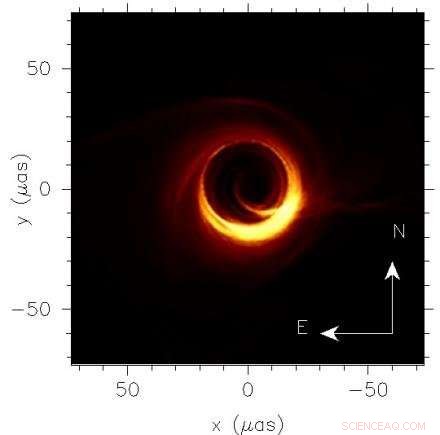
Simuleret billede som forudsagt for den supermassive sort i galaksen M87 ved de frekvenser, der er observeret med Event Horizon Telescope (230 GHz). Kredit:Moscibrodzka, Falcke, Shiokawa, Astronomi og astrofysik, V. 586, s. 15, 2016, gengivet med tilladelse © ESO
Hvorfor er kvanteteori og generel relativitet uforenelige?
På dette tidspunkt går alt galt, da ifølge almen relativitetsteori, intet bør bevæge sig hurtigere end lysets hastighed.
Lys er det substrat, der bruges i kvanteverdenen til at udveksle kræfter og transportere information i makroverdenen. Lys bestemmer, hvor hurtigt du kan forbinde årsag og konsekvenser.
Hvis du går hurtigere end lyset, du kunne se begivenheder og ændre ting, før de sker. Dette har to konsekvenser:
- På det punkt, hvor du når lysets hastighed, mens du falder indad, du skal også flyve ud med lysets hastighed for at undslippe det punkt, hvilket virker umuligt. Derfor, konventionel fysisk visdom vil fortælle dig, at intet kan undslippe et sort hul, når det har passeret det punkt, som vi kalder "begivenhedshorisonten".
- Det betyder også, at de grundlæggende principper for bevaring af kvanteinformation pludselig bliver brutalt krænket – bevarede kvantemængder kan simpelthen forsvinde bag en mur af tavshed.
Hvorvidt det er sandt, og om og hvordan teorien om tyngdekraften (eller kvantefysikken) skal modificeres, er et spørgsmål om intens debat blandt fysikere, og ingen af os kan sige, hvilken vej argumentet vil føre i sidste ende.
Findes der overhovedet sorte huller?
Selvfølgelig, al denne begejstring ville kun være berettiget, hvis sorte huller virkelig eksisterede i dette univers. Så, gør de?
I det sidste århundrede er der kommet stærke beviser for, at visse binære stjerner med intens røntgenstråling faktisk er stjerner, der er kollapset til sorte huller.
I øvrigt, i galaksernes centre finder vi ofte beviser for enorme, mørke koncentrationer af masse. Disse kan være supermassive versioner af sorte huller, muligvis dannet gennem sammensmeltningen af mange stjerner og gasskyer, der er sunket ind i midten af en galakse.
Beviserne er overbevisende, men omstændig. I det mindste har gravitationsbølger ladet os 'høre' sammensmeltningen af sorte huller, men begivenhedshorisontens signatur er stadig uhåndgribelig og indtil videre, vi har faktisk aldrig 'set' et sort hul – de har simpelthen en tendens til at være for små og for langt, og i de fleste tilfælde, Ja, sort...
Så, hvordan ville et sort hul egentlig se ud?
Hvis du kunne se lige ind i et sort hul, ville du se det mørkeste mørke, du kan forestille dig.
Men, de umiddelbare omgivelser af et sort hul kunne være lyse, da gasser spiraler indad - bremset af træk fra magnetfelter, de bærer med sig.
På grund af den magnetiske friktion vil gassen varme op til enorme temperaturer på op til flere titusinder af milliarder grader og begynde at udstråle UV-lys og røntgenstråler.
Ultravarme elektroner, der interagerer med det magnetiske felt i gassen, vil begynde at producere intens radioemission. Dermed, sorte huller kan lyse og kan være omgivet af en ring af ild, der udstråler ved mange forskellige bølgelængder.
En ring af ild med en mørk, mørkt centrum
I deres centrum, imidlertid, the event horizon still lurks and like a bird of prey it catches every photon that gets too close.
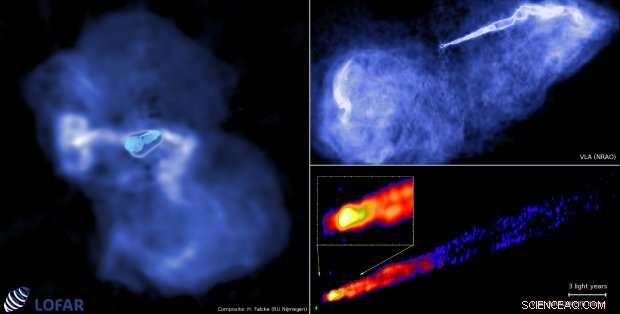
Radio images of the jet in the radio galaxy M87 – observed at lower resolution. The left frame is roughly 250, 000 light years across. Magnetic fields threading the supermassive black holes lead to the formation of a highly collimated jet that spits out hot plasma with speeds close to the speed of light . Credit:H. Falcke, Radboud university, with images from LOFAR/NRAO/MPIfR Bonn
Since space is bent by the enormous mass of a black hole, light paths will also be bent and even form into almost concentric circles around the black hole, like serpentines around a deep valley. This effect of circling light was calculated already in 1916 by the famous Mathematician David Hilbert only a few months after Albert Einstein finalised his theory of general relativity.
After orbiting the black hole multiple times, some of the light rays might escape while others will end up in the event horizon. Along this complicated light path, you can literally look into the black hole. The nothingness you see is the event horizon.
If you were to take a photo of a black hole, what you would see would be akin to a dark shadow in the middle of a glowing fog of light. Derfor, we called this feature the shadow of a black hole .
Interessant nok, the shadow appears larger than you might expect by simply taking the diameter of the event horizon. The reason is simply, that the black hole acts as a giant lens, amplifying itself.
Surrounding the shadow will be a thin 'photon ring' due to light circling the black hole almost forever. Further out, you would see more rings of light that arise from near the event horizon, but tend to be concentrated around the black hole shadow due to the lensing effect.
Fantasy or reality?
Is this pure fantasy that can only be simulated in a computer? Or can it actually be seen in practice? The answer is that it probably can.
There are two relatively nearby supermassive black holes in the universe which are so large and close, that their shadows could be resolved with modern technology.
These are the black holes in the center of our own Milky Way at a distance of 26, 000 lightyears with a mass of 4 million times the mass of the sun, and the black hole in the giant elliptical galaxy M87 (Messier 87) with a mass of 3 to 6 billion solar masses.
M87 is a thousand times further away, but also a thousand times more massive and a thousand times larger, so that both objects are expected to have roughly the same shadow diameter projected onto the sky.
Like seeing a grain of mustard in New York from Europe
Tilfældigvis, simple theories of radiation also predict that for both objects the emission generated near the event horizon would be emitted at the same radio frequencies of 230 GHz and above.
Most of us come across these frequencies only when we have to pass through a modern airport scanner but some black holes are continuously bathed in them.
The radiation has a very short wavelength of about one millimetre and is easily absorbed by water. For a telescope to observe cosmic millimetre waves it will therefore have to be placed high up, on a dry mountain, to avoid absorption of the radiation in the Earth's troposphere.
Effectively, you need a millimetre-wave telescope that can see an object the size of a mustard seed in New York from as far away as Nijmegen in the Netherlands. That is a telescope a thousand times sharper than the Hubble Space Telescope and for millimetre-waves this requires a telescope the size of the Atlantic Ocean or larger.
A virtual Earth-sized telescope
Heldigvis, we do not need to cover the Earth with a single radio dish, but we can build a virtual telescope with the same resolution by combining data from telescopes on different mountains across the Earth.
The technique is called Earth rotation synthesis and very long baseline interferometry (VLBI). The idea is old and has been tested for decades already, but it is only now possible at high radio frequencies.
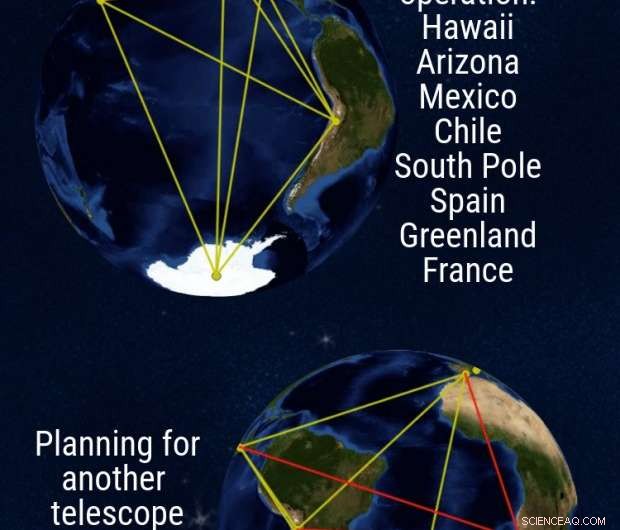
Layout of the Event Horizon Telescope connecting radio telescopes around the world (JCMT &SMA in Hawaii, AMTO in Arizona, LMT in Mexico, ALMA &APEX in Chile, SPT on the South Pole, IRAM 30m in Spain). The red lines are to a proposed telescope on the Gamsberg in Namibia that is still being planned. Credit:ScienceNordic / Forskerzonen. Compiled from images provided by the author
The first successful experiments have already shown that event horizon structures can be probed at these frequencies. Now high-bandwidth digital equipment and large telescopes are available to do this experiment on a large scale.
Work is already underway
I am one of the three Principal Investigators of the BlackHoleCam project. BlackHoleCam is an EU-funded project to finally image, measure and understand astrophysical black holes. Our European project is part of a global collaboration known as the Event Horizon Telescope consortium – a collaboration of over 200 scientists from Europe, the Americas, Asia, and Africa. Together we want to take the first picture of a black hole.
In April 2017 we observed the Galactic Center and M87 with eight telescopes on six different mountains in Spain, Arizona, Hawaii, Mexico, Chile, and the South Pole.
All telescopes were equipped with precise atomic clocks to accurately synchronise their data. We recorded multiple petabytes of raw data, thanks to surprisingly good weather conditions around the globe at the time.
We are all excited about working with this data. Selvfølgelig, even in the best of all cases, the images will never look as pretty as the computer simulations. Men, at least they will be real and whatever we see will be interesting in its own right.
To get even better images telescopes in Greenland and France are being added. Moreover, we have started raising funds for additional telescopes in Africa and perhaps elsewhere and we are even thinking about telescopes in space.
A 'photo' of a black hole
If we actually succeed in seeing an event horizon, we will know that the problems we have in rhyming quantum theory and general relativity are not abstract problems, but are very real. And we can point to them in the very real shadowy regions of black holes in a clearly marked region of our universe.
This is perhaps also the place where these problems will eventually be solved.
We could do this by obtaining sharper images of the shadow, or maybe by tracing stars and pulsars as they orbit around black holes, through measuring spacetime ripples as black holes merge, or as is most likely, by using all of the techniques that we now have, together, to probe black holes.
A once exotic concept is now a real working laboratory
As a student, I wondered what to study:particle physics or astrophysics? After reading many popular science articles, my impression was that particle physics had already reached its peak. This field had established an impressive standard model and was able to explain most of the forces and the particles governing our world.
Astronomy though, had just started to explore the depths of a fascinating universe. There was still a lot to be discovered. And I wanted to discover something.
Til sidst, I chose astrophysics as I wanted to understand gravity. And since you find the most extreme gravity near black holes, I decided to stay as close to them as possible.
I dag, what used to be an exotic concept when I started my studies, promises to become a very real and very much visible physics laboratory in the not too distant future.
This story is republished courtesy of ScienceNordic, the trusted source for English-language science news from the Nordic countries. Læs den originale historie her.
 Varme artikler
Varme artikler
-
 Touchdown:NASAs Perseverance rover klar til at søge efter liv på MarsDette NASA-foto viser NASAs første billede fra Perseverance-roveren, da den landede på Mars overflade den 18. februar, 2021 Efter syv måneder i rummet, NASAs Perseverance-rover overvandt en anspæn
Touchdown:NASAs Perseverance rover klar til at søge efter liv på MarsDette NASA-foto viser NASAs første billede fra Perseverance-roveren, da den landede på Mars overflade den 18. februar, 2021 Efter syv måneder i rummet, NASAs Perseverance-rover overvandt en anspæn -
 Stop aldring i rummetNanoceria. Kredit:Gianni Ciofani rynker, muskelsmerter, højt blodtryk og en klodset hjerne er alle naturlige konsekvenser af at blive gammel. Da vores celler ruster over tid, en nøgle til at bekæm
Stop aldring i rummetNanoceria. Kredit:Gianni Ciofani rynker, muskelsmerter, højt blodtryk og en klodset hjerne er alle naturlige konsekvenser af at blive gammel. Da vores celler ruster over tid, en nøgle til at bekæm -
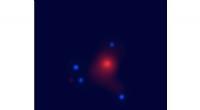 Forskningsgruppe bekræfter planetmasseobjekter i ekstragalaktiske systemerRøntgenbillede af gravitationslinsesystemet SDSS J1004+4112 taget af Chandra X-ray Observatory. Den centrale røde forlængede emission er fra den varme gas i forgrundslinsens galaksehob ved z=0,68, og
Forskningsgruppe bekræfter planetmasseobjekter i ekstragalaktiske systemerRøntgenbillede af gravitationslinsesystemet SDSS J1004+4112 taget af Chandra X-ray Observatory. Den centrale røde forlængede emission er fra den varme gas i forgrundslinsens galaksehob ved z=0,68, og -
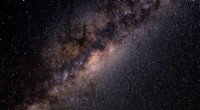 Forskere løser mysteriet om, hvordan det meste antistof i Mælkevejen dannesKredit:Australian National University Et hold af internationale astrofysikere ledet af The Australian National University (ANU) har vist, hvordan det meste af antistoffet i Mælkevejen dannes. Ant
Forskere løser mysteriet om, hvordan det meste antistof i Mælkevejen dannesKredit:Australian National University Et hold af internationale astrofysikere ledet af The Australian National University (ANU) har vist, hvordan det meste af antistoffet i Mælkevejen dannes. Ant
- Forsker undersøger små RNA'ers rolle i kommunikationen mellem celler
- Hvordan man fortæller Mand fra Kvinde Crickets
- Samsung 7nm EUV LPP betegner en ny dag for sin chipfremstillingsfremtid
- Undersøgelse bruger AI-teknologi til at begynde at forudsige placeringer af efterskælv
- Ny metode til registrering af ondsindet e-mail overgår 60 antivirusmotorer
- Succes med præstationsvurdering afhænger af hyppig feedback og god standardindstilling


